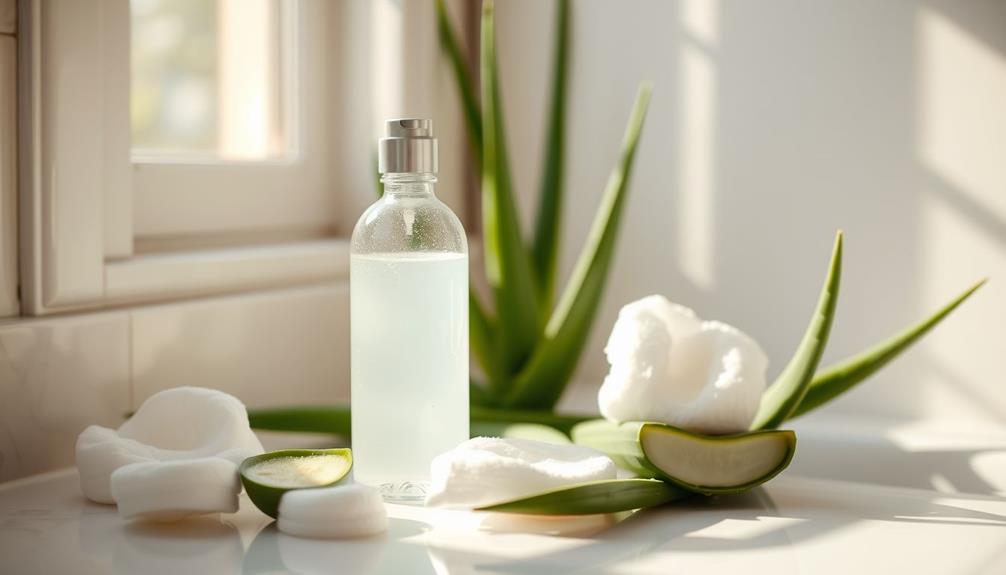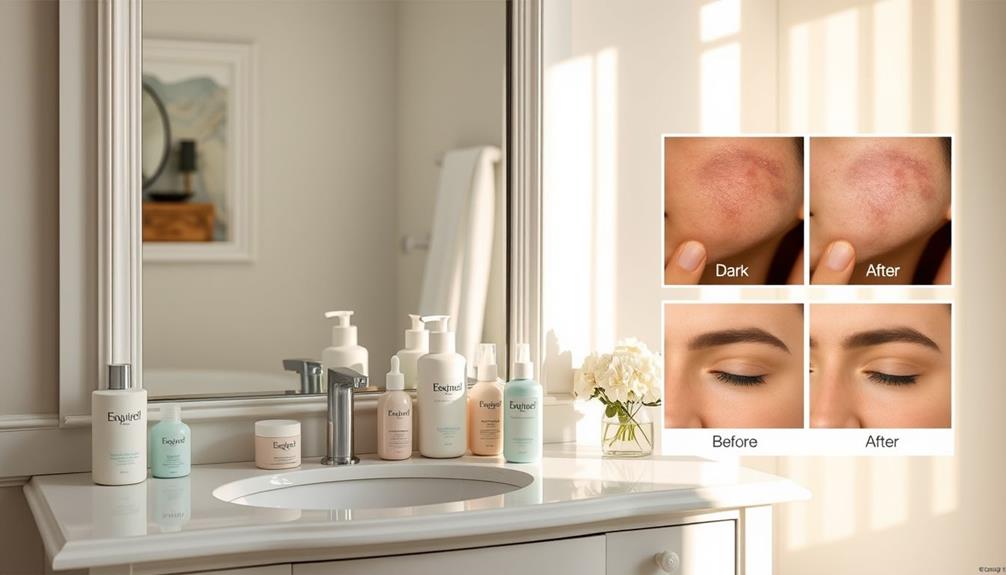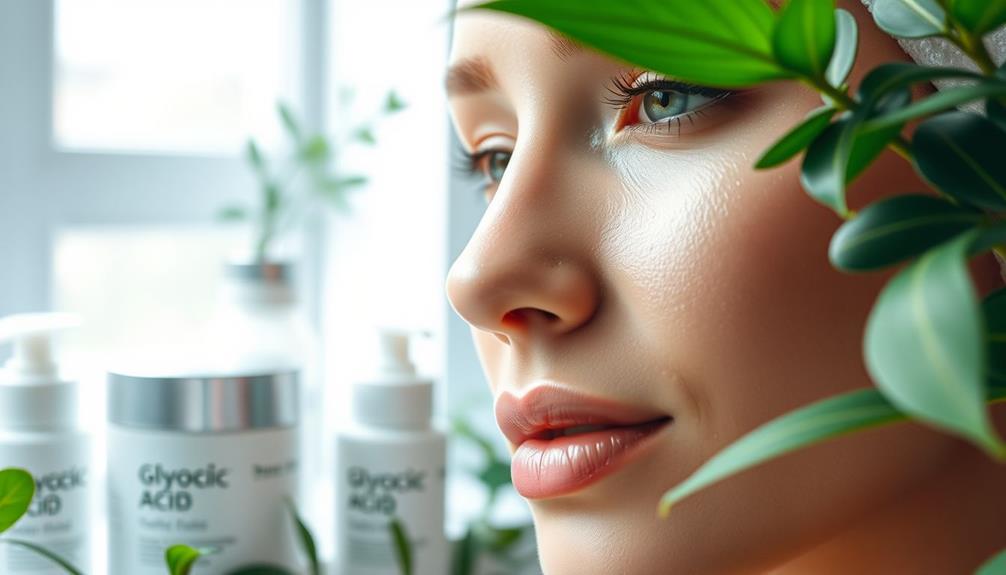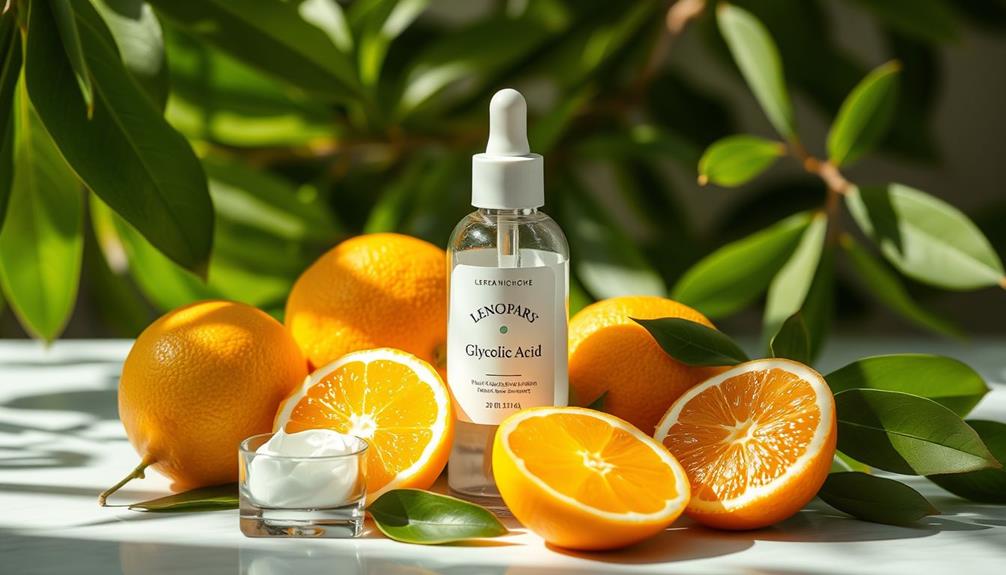A glycolic acid toner exfoliates your skin, unclogs pores, and enhances overall texture, making it a game changer for a radiant complexion. It promotes cell turnover to reveal fresher, smoother skin and stimulates collagen production for improved elasticity. This toner effectively addresses issues like acne, hyperpigmentation, and sun damage, while also increasing the absorption of other skincare products. If you've got oily skin, you'll especially benefit, but even dry or sensitive types can enjoy it with caution. For ideal results, you should know how to incorporate it into your routine—and there's more to discover about maximizing its benefits!
Key Takeaways
- Glycolic acid toners exfoliate the skin by breaking down dead skin cell bonds, promoting a smoother and brighter complexion.
- They unclog pores, reducing the appearance of enlarged pores and preventing acne breakouts.
- These toners stimulate collagen production, helping to reduce fine lines and improve skin elasticity.
- Glycolic acid toners enhance the absorption of other skincare products, maximizing their effectiveness.
What Is Glycolic Acid?

Glycolic acid is a powerful alpha hydroxy acid (AHA) from sugar cane that exfoliates and penetrates the skin deeply. Its small molecular size allows it to break down the bonds between dead skin cells effectively. When you use glycolic acid, you promote cell turnover, leading to smoother, brighter skin.
For those concerned about hair and skin health, incorporating effective products can be essential; consider exploring hair products for curly hair that complement your skincare routine. By removing dead skin cells, it reveals a fresh layer underneath, enhancing your overall skin texture.
This acid isn't just about exfoliation; it also stimulates collagen production, which is crucial for maintaining skin elasticity. As a result, you'll notice a reduction in fine lines and wrinkles over time.
Additionally, glycolic acid is effective in treating acne by preventing dead skin cells from clogging your pores, helping to keep your complexion clear and radiant.
Incorporating glycolic acid into your routine can also boost the absorption of other skincare products, making them work more effectively. Regular use can transform your skin, giving you that sought-after glow while improving its overall clarity.
How Glycolic Acid Works
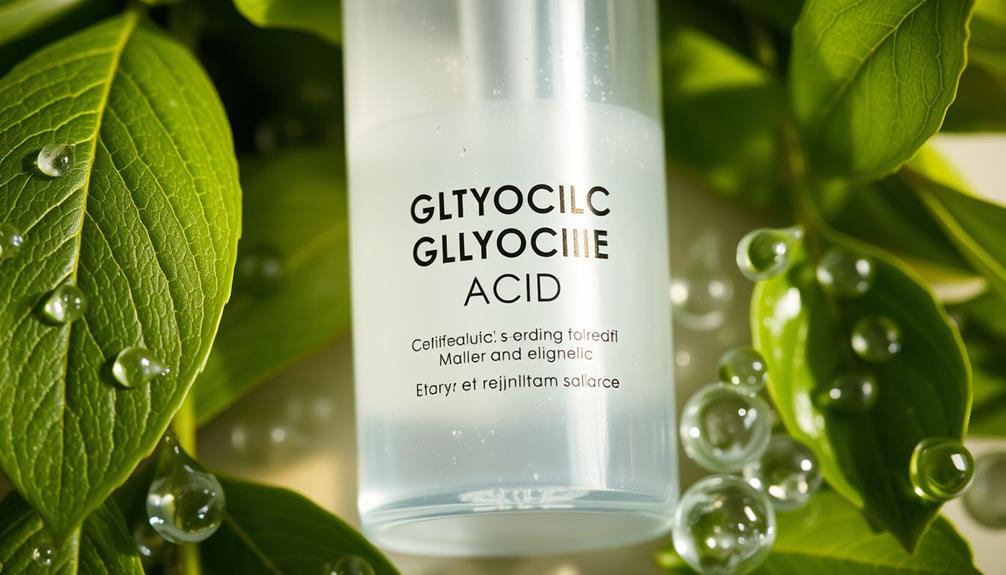
Glycolic acid works by breaking down the bonds that hold dead skin cells together, making it easier for your skin to shed them.
Its small molecular size allows it to penetrate deeply, enhancing exfoliation and promoting a smoother texture.
Additionally, glycolic acid can help improve overall skin health, much like how certain essential oils in aromatherapy can promote skin health.
You'll also benefit from its ability to stimulate collagen production, which helps improve firmness and reduce fine lines.
Exfoliation Mechanism Explained
This powerful alpha-hydroxy acid breaks down the bonds between dead skin cells, making it easier for you to exfoliate and reveal fresh, radiant skin.
Glycolic acid enhances exfoliation by penetrating the skin's surface, promoting cell turnover more effectively than other AHAs. As it dissolves dead skin cells, you're not only unclogging pores but also preventing acne, leading to a clearer complexion.
Additionally, incorporating essential oils like lavender can complement your skincare routine by promoting relaxation and reducing stress, which may further enhance your skin's appearance through improved overall well-being, as seen in essential oils for relaxation.
Regular use of glycolic acid can greatly improve your skin texture and tone. It works wonders on hyperpigmentation and sun damage, helping to even out your skin's appearance.
Plus, as glycolic acid stimulates fibroblast activity, you'll notice increased collagen production, which boosts skin elasticity and reduces the appearance of fine lines and wrinkles.
With these benefits, glycolic acid truly stands out as a key player in your skincare routine. By incorporating a glycolic acid toner, you can effortlessly enhance your skin's health and luminosity.
Skin Penetration Depth
By penetrating deeper into the skin than other alpha hydroxy acids, glycolic acid effectively enhances exfoliation and promotes a healthier complexion. Its small molecular size allows it to reach the stratum corneum, encouraging cell turnover and revealing fresher skin beneath.
The deeper skin penetration depth means glycolic acid can dissolve the bonds holding dead skin cells together, leading to smoother skin texture and a more even tone. This process can also be complemented by proper hydration and moisturization, which enhances the overall effectiveness of exfoliation, similar to sustainable fashion practices that promote skin health and environmental consciousness.
Consider these benefits of glycolic acid:
- Enhanced Exfoliating Effects: Removes dead skin cells more effectively than larger AHAs.
- Increased Cell Turnover: Promotes faster regeneration of new skin cells.
- Boosted Collagen Production: Stimulates fibroblasts in the dermis for firmer skin.
Key Benefits of Glycolic Acid Toner
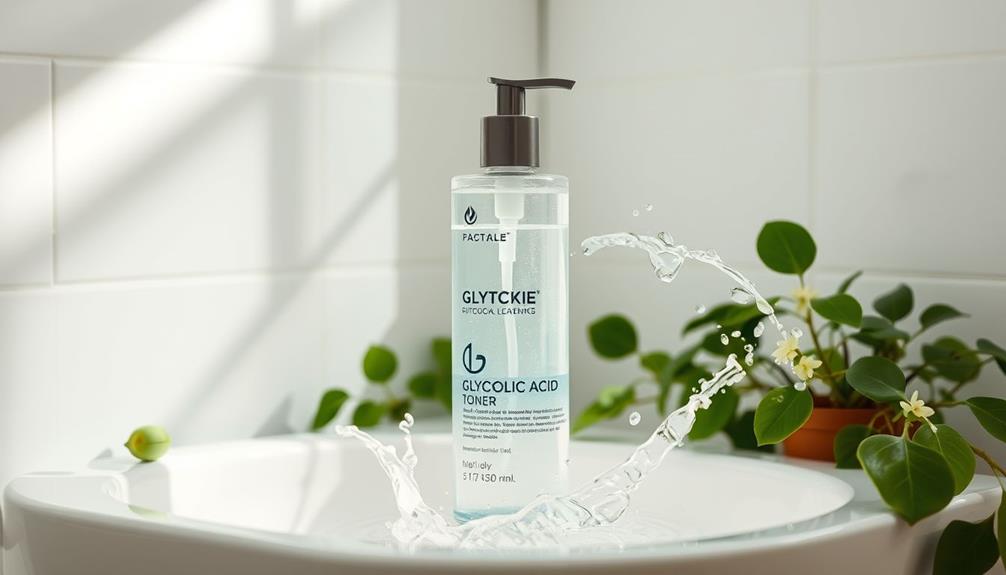
What if you could reveal smoother, brighter skin while also tackling issues like enlarged pores and acne? Using a glycolic acid toner can transform your skincare routine by providing key benefits that enhance your complexion. This effective exfoliant promotes the shedding of dead skin cells, leading to improved skin texture and radiance.
Here's a quick look at the benefits:
| Benefit | Description | Impact on Skin |
|---|---|---|
| Exfoliation | Removes dead skin cells | Smooth, bright skin |
| Collagen Production | Stimulates collagen synthesis | Fewer fine lines and wrinkles |
| Pore Refinement | Clears debris from pores | Reduced appearance of enlarged pores |
| Acne Prevention | Prevents clogging by dead skin cells and sebum | Clearer skin, reduced breakouts |
Regular use of a glycolic acid toner not only enhances your skin's texture but also boosts the absorption of other skincare products. So, if you're looking to tackle multiple skin concerns, incorporating this toner into your regimen might be the solution you need!
Ideal Skin Types for Glycolic Acid

When considering glycolic acid toners, it's essential to understand how they interact with different skin types.
If you have oily skin, you'll likely see great benefits, while those with dry or sensitive skin should approach with caution.
Let's explore how to make the most of glycolic acid for your specific skin type.
Oily Skin Benefits
Glycolic acid toners provide essential benefits for oily skin, effectively combating excess sebum and helping to prevent clogged pores. By incorporating glycolic acid into your skincare routine, you'll notice a significant improvement in your skin's texture and clarity. The exfoliating properties of glycolic acid work to remove dead skin cells, which can lead to shine and dullness, making your complexion look fresh and vibrant.
Here are some key benefits of using glycolic acid toners for oily skin:
- Reduces acne breakouts: Regular use helps to keep pores clear, minimizing the risk of blemishes.
- Minimizes enlarged pores: Glycolic acid toners can refine your skin's texture, making pores appear smaller.
- Improves skin clarity: Clinical studies show a reduction in acne lesions, leading to a clearer complexion.
Incorporating glycolic acid toners into your routine can transform your oily skin, helping you achieve that smooth, radiant look you desire.
Dry Skin Considerations
For those with dry skin, using glycolic acid toners requires careful consideration to avoid irritation and maintain moisture balance. Glycolic acid can be harsh on dry skin, so you should start with lower concentrations and use it sparingly—perhaps once a week—to gauge your skin tolerance. This approach helps you monitor how your skin reacts without overwhelming it.
Incorporating hydrating ingredients in your toner can considerably enhance comfort. Look for toners that blend glycolic acid with ingredients like hyaluronic acid or glycerin. These components help counteract the drying effects of glycolic acid, ensuring your skin stays hydrated.
It's also essential to follow up with a strong moisturizer after applying glycolic acid toner. This step locks in moisture and supports your skin's barrier function, reducing the risk of irritation.
Sensitive Skin Precautions
Sensitive skin requires special precautions when using glycolic acid to avoid irritation and guarantee a positive experience.
While glycolic acid is an effective exfoliant for many skin types, those with sensitive skin should be particularly cautious. Start with a lower concentration, like 5%, to minimize skin irritation, and gradually increase as your skin adapts.
To help you navigate using glycolic acid safely, consider the following tips:
- Patch Test: Always perform a patch test on a small area of skin to check for adverse reactions.
- Monitor Skin Condition: Keep an eye on how your skin reacts over time, especially during seasonal changes that might affect sensitivity.
- Use at Night: Apply glycolic acid products in the evening to reduce the risk of sun sensitivity during the day.
Usage Guidelines for Glycolic Acid Toner

To get the best results from a glycolic acid toner, start with an alcohol-free formula and apply it once a week in the evening to test your skin's sensitivity.
After a week, assess how your skin reacts. If you experience no irritation, you can gradually increase the usage frequency to 2-3 times a week.
Oily or acne-prone skin might benefit from using the toner 3-4 times a week, while those with dry skin should limit it to 1-2 times weekly.
Always follow up with a good moisturizer after applying the toner to prevent dryness and irritation, as glycolic acid can leave your skin feeling a bit tight.
You need to be diligent about sun protection, too. Since glycolic acid can increase your skin's sensitivity to UV rays, applying sunscreen daily is essential.
This will help protect your skin from potential damage while allowing you to enjoy the benefits of your glycolic acid toner.
Potential Side Effects to Consider
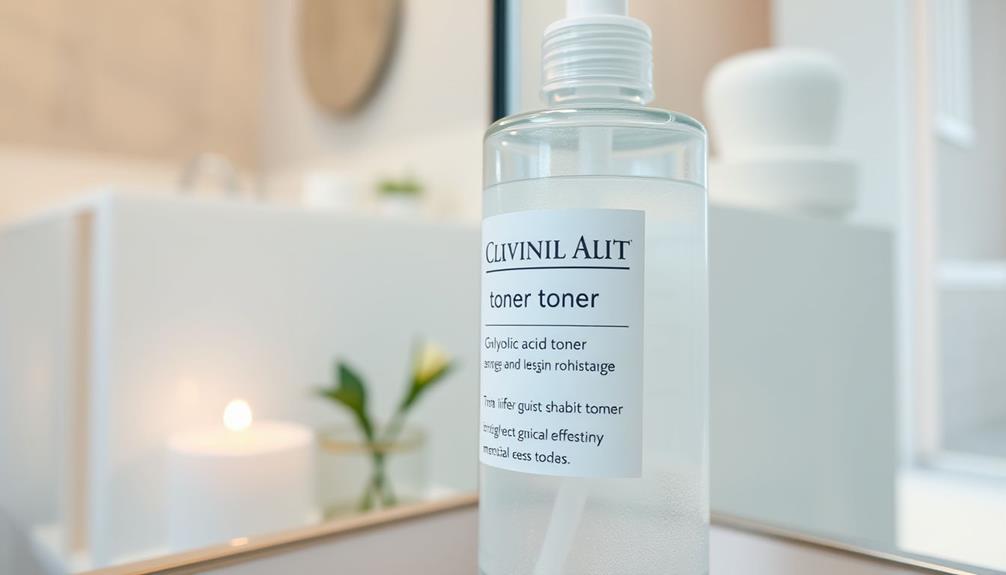
Glycolic acid toners can lead to irritation, redness, and dryness, particularly if you're not accustomed to acid-based products. It's important to be aware of potential side effects to guarantee a positive experience with glycolic acid. Here are some factors to reflect on:
- Skin Irritation: New users might experience increased sensitivity, especially those with delicate skin.
- Sun Sensitivity: Glycolic acid can heighten your skin's sensitivity to sunlight, making diligent sunscreen application vital.
- Hyperpigmentation: If used improperly or without sun protection, glycolic acid may cause uneven skin tone, particularly in individuals with darker skin.
Monitor your skin's reactions closely. If you notice any persistent irritation or discomfort, it's wise to reduce the frequency of use or switch to a lower concentration.
Combining Glycolic Acid With Other Ingredients

Combining glycolic acid with other beneficial ingredients can enhance your skincare routine, maximizing its exfoliating effects while minimizing irritation. By thoughtfully layering products, you can achieve superior results for your skin.
| Ingredient | Benefits | Best Pairing |
|---|---|---|
| Glycolic Acid | Exfoliates dead skin cells | Hyaluronic Acid |
| Hyaluronic Acid | Hydrates and retains moisture | Glycolic Acid |
| Niacinamide | Improves skin tone and reduces redness | Glycolic Acid |
| Retinol | Anti-aging properties | Glycolic Acid |
| Vitamin C | Brightens and evens skin tone | Glycolic Acid |
For instance, pairing glycolic acid with hydrating ingredients like hyaluronic acid can help keep your skin moisturized while minimizing irritation. When combined with niacinamide, you'll notice improvements in skin tone and texture. If you're looking for anti-aging benefits, consider using glycolic acid with retinol, but be sure to space them out to avoid irritation. Finally, using glycolic acid with vitamin C can enhance your skin's brightness; just remember to apply them at different times for maximum effect.
Best Practices for Incorporating Toner
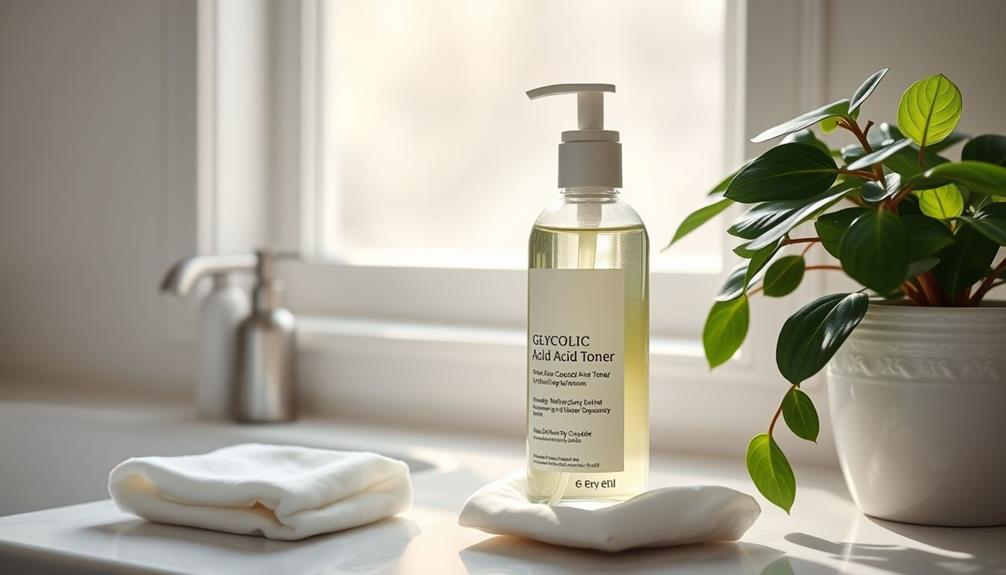
When incorporating a glycolic acid toner into your skincare routine, start slowly by using it just once a week to gauge your skin's tolerance. This gradual approach allows you to monitor how your skin reacts before increasing to 2-3 times a week as needed.
Here are some best practices to evaluate:
- Choose an alcohol-free toner: This minimizes irritation while maximizing exfoliation benefits and maintaining skin hydration.
- Follow with a moisturizer: Always apply a moisturizer after the toner to restore moisture and protect your skin barrier post-exfoliation.
- Apply in the evening: Doing so reduces sun sensitivity, as glycolic acid can make your skin more vulnerable to UV rays.
Common Misconceptions About Glycolic Acid
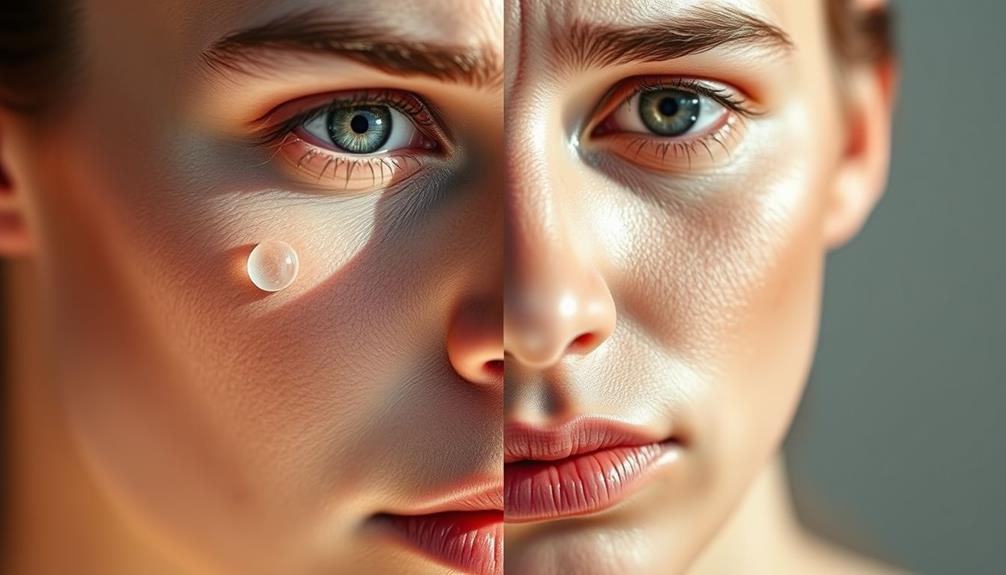
Many people often misunderstand glycolic acid, believing it's only suitable for oily skin or that it provides instant results.
In reality, glycolic acid is a versatile chemical exfoliant that can benefit all skin types, including dry and sensitive skin, when used correctly. You can safely incorporate a low percentage, around 5%, into your daily skincare routine without causing irritation.
Another misconception is that you'll see immediate improvements from glycolic acid. Instead, it works gradually by promoting cell turnover, so consistent use over several weeks is essential for visible benefits.
Many users think they should apply glycolic acid in the morning, but it's better suited for nighttime application due to increased sun exposure risks.
It's vital to remember that you can't skip sunscreen while using glycolic acid. This ingredient can make your skin more vulnerable to UV damage, so proper sun protection is a must.
Selecting the Right Glycolic Acid Toner
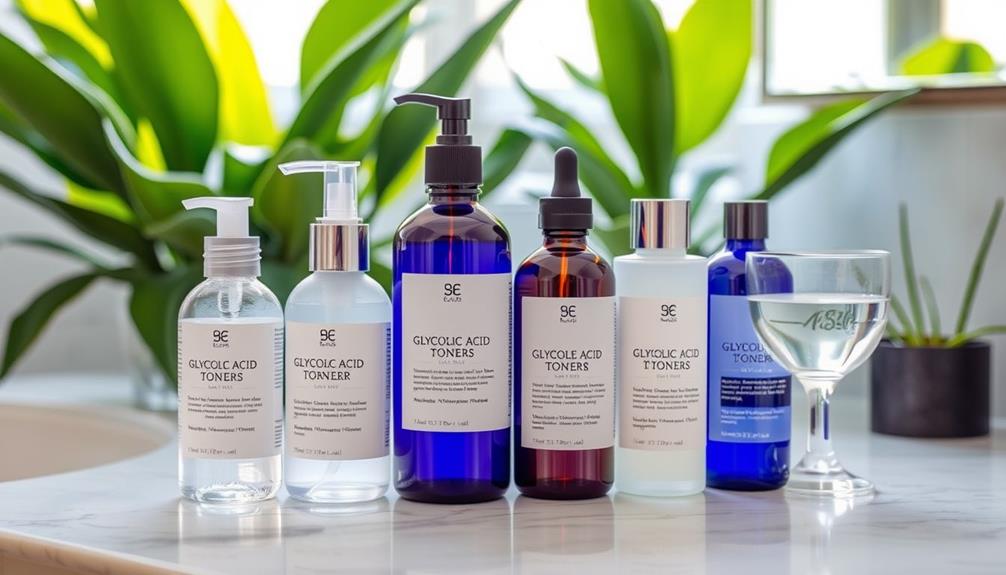
When choosing a glycolic acid toner, consider your skin type to guarantee it meets your specific needs.
Pay attention to ingredient synergy, as combining glycolic acid with hydrating or soothing elements can enhance its benefits.
Additionally, think about how often you plan to use the toner to avoid irritation while still enjoying its exfoliating effects.
Skin Type Considerations
Selecting the right glycolic acid toner involves understanding your skin type to maximize its benefits and minimize any potential irritation. Different skin types react differently to glycolic acid, so it's important to choose wisely.
- Normal and Oily Skin: You can use a glycolic acid toner 3-4 times a week to exfoliate and unclog pores, effectively reducing acne breakouts.
- Combination Skin: A moderate approach works best; consider alternating between glycolic acid and a gentler toner to avoid overwhelming your skin.
- Dry or Sensitive Skin: Start with a lower concentration (around 5%) and limit usage to once a week to prevent irritation and dryness.
Ingredient Synergy
Finding the right glycolic acid toner involves understanding how different ingredients work together to enhance your skin's health and the effectiveness of the product.
Start by looking for toners with a pH around 4, which maximizes glycolic acid's exfoliation benefits. A concentration of 5% to 10% is ideal for effective exfoliation without overwhelming your skin.
Incorporating hydrating ingredients like hyaluronic acid or glycerin can help counteract any dryness or irritation that glycolic acid might cause. If you have sensitive skin, consider toners with soothing agents such as aloe vera or chamomile to enhance tolerance and calm your complexion.
Ingredient synergy is key, so choose toners that complement other active ingredients. For instance, pairing glycolic acid with niacinamide can target multiple skin concerns, like uneven tone and texture, while maintaining skin health. Salicylic acid can also be a good match if you're dealing with acne-prone skin.
Application Frequency Guidelines
To guarantee your skin adapts well, start by applying a glycolic acid toner just once a week and gradually increase the frequency based on your skin's tolerance. For those with oily or acne-prone skin, you might find that using the toner 3-4 times a week works best. However, if you have dry or sensitive skin, it's safer to limit your use to 1-2 times weekly.
Consider these guidelines to help determine your application frequency:
- Monitor your skin: Keep an eye on any signs of irritation, like redness or excessive dryness.
- Moisturize after use: Always follow up with a good moisturizer to maintain hydration and minimize irritation.
- Be patient: Give your skin time to adjust before increasing the frequency of exfoliation.
Conclusion
Just like a gardener nurturing a blooming flower, incorporating a glycolic acid toner into your skincare routine can help your skin flourish.
With its gentle exfoliation and brightening benefits, this toner acts as sunlight, helping to uncover the vibrant, fresh layers beneath.
As you commence on this journey, remember to listen to your skin and provide it with the care it needs.
Soon, you'll disclose a complexion that radiates confidence, much like a garden in full bloom.
